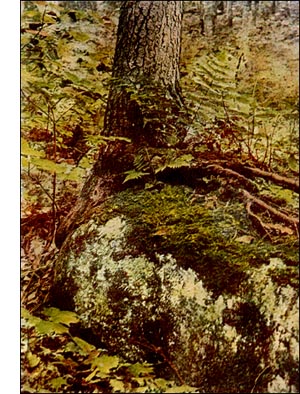Mosses and Lichens
 No frequenter of the woods can be unfamiliar with the more conspicuous lichens and mosses. It is with them that nature adorns her bare unsightly children. She drapes the timeworn evergreens with gray fringes and decks the old tree-stumps with red or yellow corals. Soft lichens spread over the ground in the deep shade of the pine trees, while pale green or yellow rosettes creep over the fence-rails and the big rocks in the pasture lot.
No frequenter of the woods can be unfamiliar with the more conspicuous lichens and mosses. It is with them that nature adorns her bare unsightly children. She drapes the timeworn evergreens with gray fringes and decks the old tree-stumps with red or yellow corals. Soft lichens spread over the ground in the deep shade of the pine trees, while pale green or yellow rosettes creep over the fence-rails and the big rocks in the pasture lot. Lichens and mosses are met with all over the world, in the cold North and in the sunny South, in the East and in the West, by the seashore and on the highest mountain peaks. They are the first growths to appear on the rocks and in the places which give no foothold to other plants. When the side of a mountain is torn away by frosts and floods, and the bared rocks, shorn of their forest trees and shrubs, are left unsightly with nothing to tempt other plants to make a home on their ledges, then the lichens come and cover the bared cliffs with delicate traceries and mantles of exquisite grays and greens. They need no soil, a polished rock will meet their need.
Who has not loved the mossy banks and the little velvet cushions which cling to the plaster of the old wall or spring up in the crevices of the pavement, giving restful spots of green to the dreary monotony of brick and stone? Children play with mosses and lichens. Poets sing their charms. Artists endeavour to reproduce their wonderful colours traced on bark and rock.
Aside from their artistic charm, mosses and lichens have other charms for all who will pause awhile to study their habits, and for all who will linger long enough to make out what the plants are doing in their humble way. They have wonderful mechanical contrivances for the physicist, curious processes of interest to the chemist, and many suggestions for the philosopher.
Lichens
Liverworts or Hepatics
Mosses